An Analysis of Prayer in Practical Theology: Faith, Life, and God
VerifiedAdded on 2022/10/01
|5
|1108
|157
Essay
AI Summary
This essay explores the significance of prayer in practical theology, emphasizing its role as a method and activity that structures faith and its expression. It highlights the connection between prayer, faith, and life, noting how individuals seek comfort and aid in their struggles through belief and spirituality. The essay discusses theological themes revealed through prayer, including knowledge about God, the relationship between God and life, the precedence of God, the image of God, and the extent of attachment to God. It also touches on how God communicates with individuals and the understanding of God's will and eternal plan. The essay concludes that prayer is more than mere thinking; it involves considering God's thoughts as revealed, which forms the basis for addressing God in prayer. Desklib offers resources for students, including past papers and solved assignments, to further explore this topic.
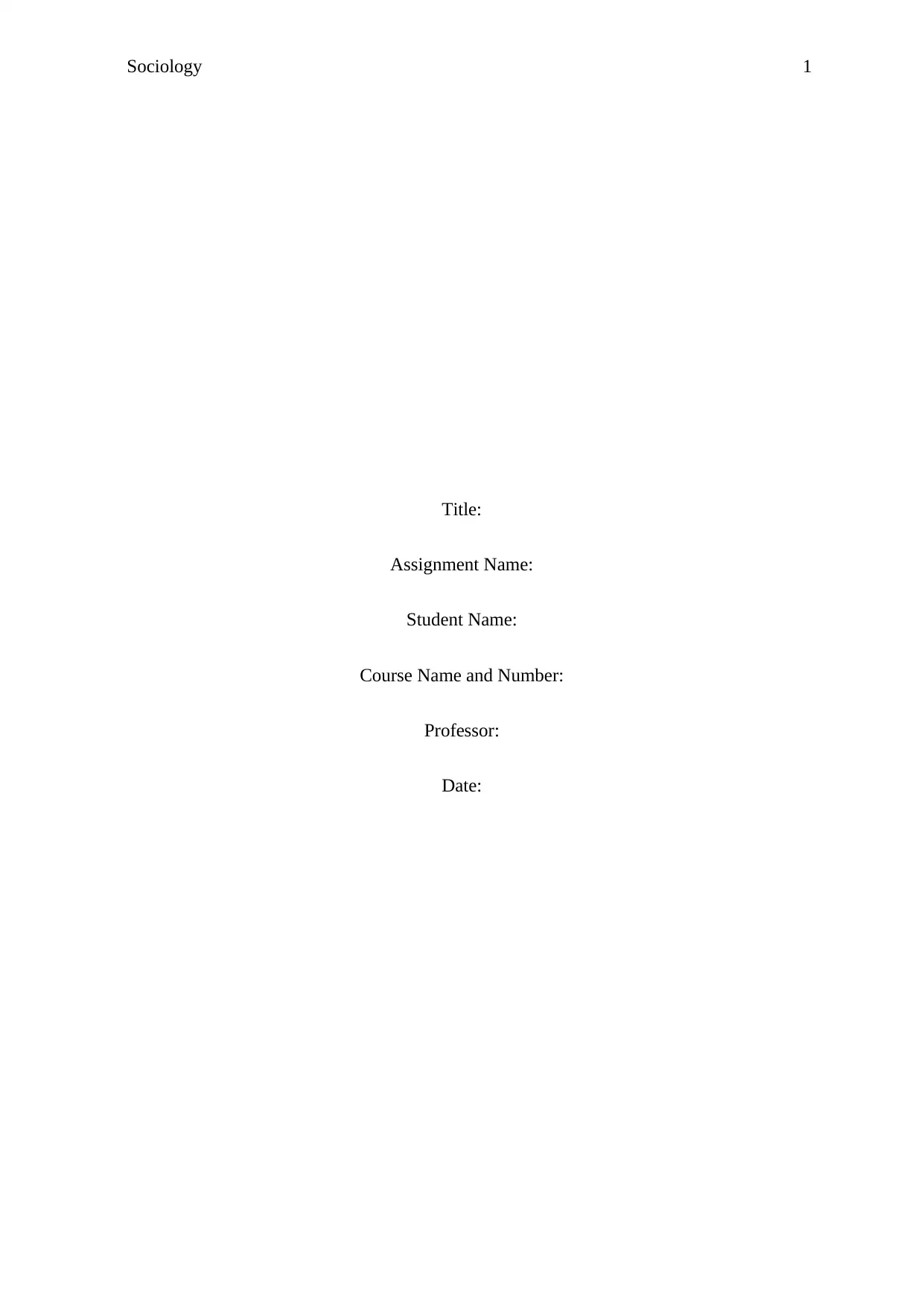
Sociology 1
Title:
Assignment Name:
Student Name:
Course Name and Number:
Professor:
Date:
Title:
Assignment Name:
Student Name:
Course Name and Number:
Professor:
Date:
Paraphrase This Document
Need a fresh take? Get an instant paraphrase of this document with our AI Paraphraser
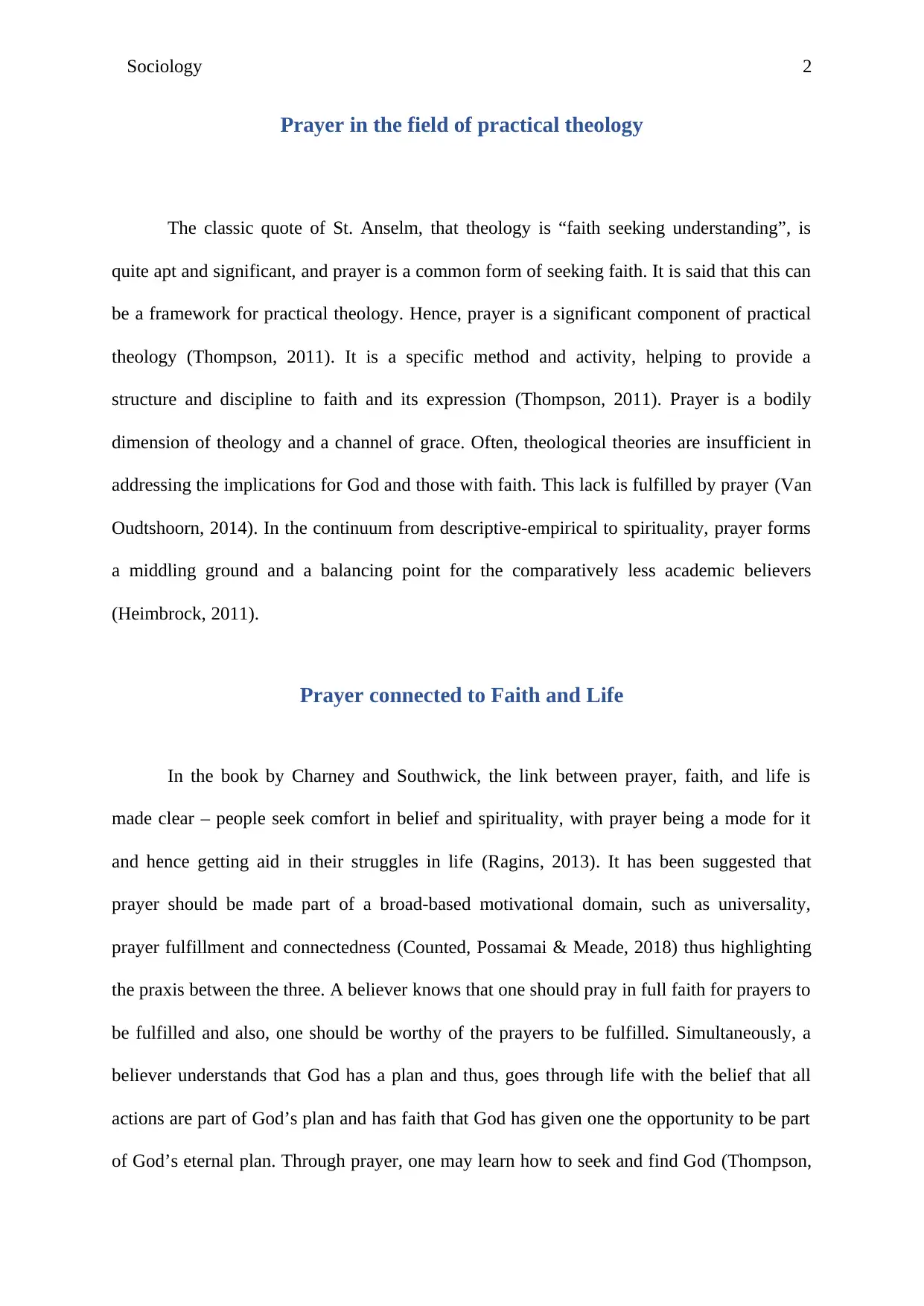
Sociology 2
Prayer in the field of practical theology
The classic quote of St. Anselm, that theology is “faith seeking understanding”, is
quite apt and significant, and prayer is a common form of seeking faith. It is said that this can
be a framework for practical theology. Hence, prayer is a significant component of practical
theology (Thompson, 2011). It is a specific method and activity, helping to provide a
structure and discipline to faith and its expression (Thompson, 2011). Prayer is a bodily
dimension of theology and a channel of grace. Often, theological theories are insufficient in
addressing the implications for God and those with faith. This lack is fulfilled by prayer (Van
Oudtshoorn, 2014). In the continuum from descriptive-empirical to spirituality, prayer forms
a middling ground and a balancing point for the comparatively less academic believers
(Heimbrock, 2011).
Prayer connected to Faith and Life
In the book by Charney and Southwick, the link between prayer, faith, and life is
made clear – people seek comfort in belief and spirituality, with prayer being a mode for it
and hence getting aid in their struggles in life (Ragins, 2013). It has been suggested that
prayer should be made part of a broad-based motivational domain, such as universality,
prayer fulfillment and connectedness (Counted, Possamai & Meade, 2018) thus highlighting
the praxis between the three. A believer knows that one should pray in full faith for prayers to
be fulfilled and also, one should be worthy of the prayers to be fulfilled. Simultaneously, a
believer understands that God has a plan and thus, goes through life with the belief that all
actions are part of God’s plan and has faith that God has given one the opportunity to be part
of God’s eternal plan. Through prayer, one may learn how to seek and find God (Thompson,
Prayer in the field of practical theology
The classic quote of St. Anselm, that theology is “faith seeking understanding”, is
quite apt and significant, and prayer is a common form of seeking faith. It is said that this can
be a framework for practical theology. Hence, prayer is a significant component of practical
theology (Thompson, 2011). It is a specific method and activity, helping to provide a
structure and discipline to faith and its expression (Thompson, 2011). Prayer is a bodily
dimension of theology and a channel of grace. Often, theological theories are insufficient in
addressing the implications for God and those with faith. This lack is fulfilled by prayer (Van
Oudtshoorn, 2014). In the continuum from descriptive-empirical to spirituality, prayer forms
a middling ground and a balancing point for the comparatively less academic believers
(Heimbrock, 2011).
Prayer connected to Faith and Life
In the book by Charney and Southwick, the link between prayer, faith, and life is
made clear – people seek comfort in belief and spirituality, with prayer being a mode for it
and hence getting aid in their struggles in life (Ragins, 2013). It has been suggested that
prayer should be made part of a broad-based motivational domain, such as universality,
prayer fulfillment and connectedness (Counted, Possamai & Meade, 2018) thus highlighting
the praxis between the three. A believer knows that one should pray in full faith for prayers to
be fulfilled and also, one should be worthy of the prayers to be fulfilled. Simultaneously, a
believer understands that God has a plan and thus, goes through life with the belief that all
actions are part of God’s plan and has faith that God has given one the opportunity to be part
of God’s eternal plan. Through prayer, one may learn how to seek and find God (Thompson,
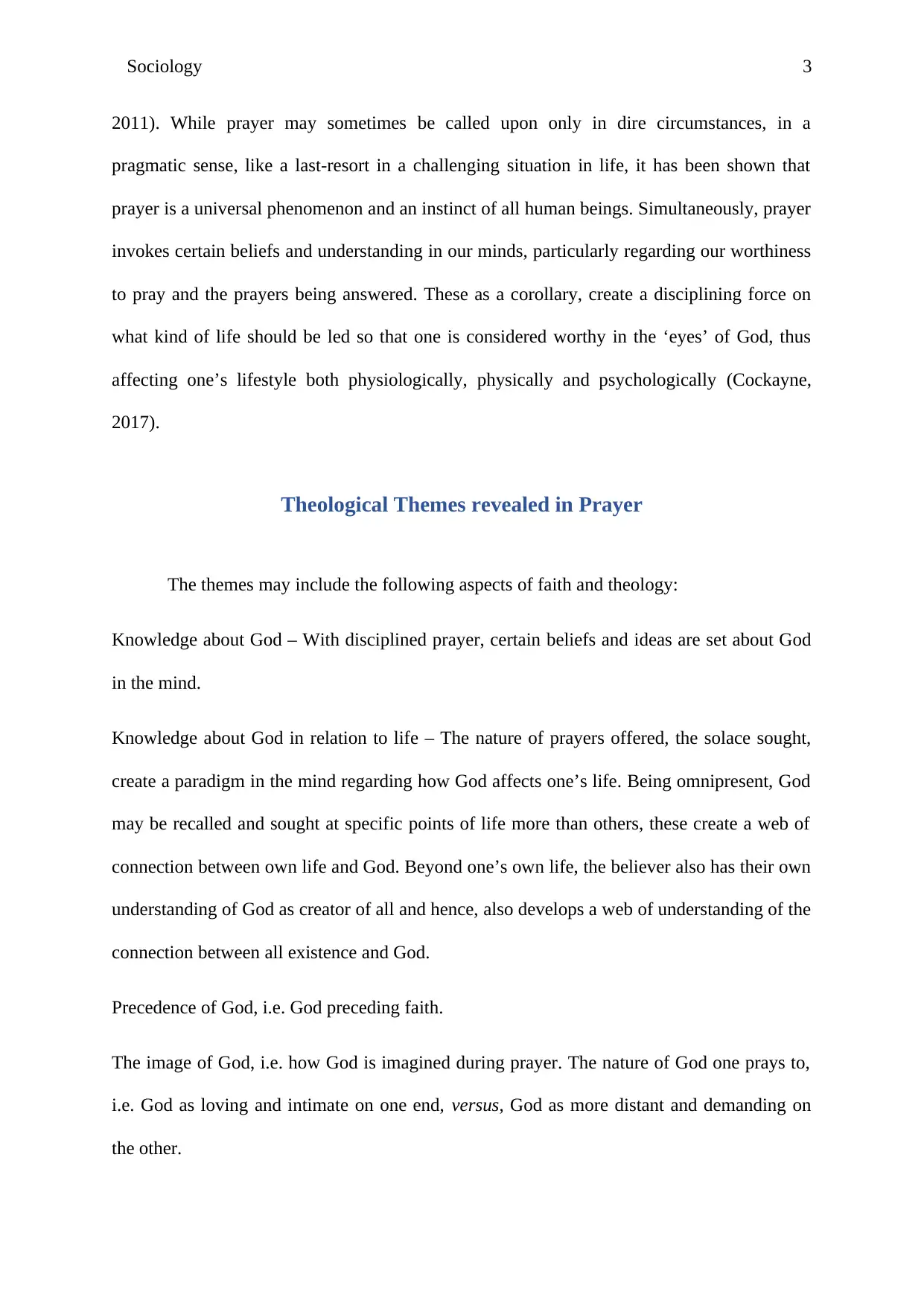
Sociology 3
2011). While prayer may sometimes be called upon only in dire circumstances, in a
pragmatic sense, like a last-resort in a challenging situation in life, it has been shown that
prayer is a universal phenomenon and an instinct of all human beings. Simultaneously, prayer
invokes certain beliefs and understanding in our minds, particularly regarding our worthiness
to pray and the prayers being answered. These as a corollary, create a disciplining force on
what kind of life should be led so that one is considered worthy in the ‘eyes’ of God, thus
affecting one’s lifestyle both physiologically, physically and psychologically (Cockayne,
2017).
Theological Themes revealed in Prayer
The themes may include the following aspects of faith and theology:
Knowledge about God – With disciplined prayer, certain beliefs and ideas are set about God
in the mind.
Knowledge about God in relation to life – The nature of prayers offered, the solace sought,
create a paradigm in the mind regarding how God affects one’s life. Being omnipresent, God
may be recalled and sought at specific points of life more than others, these create a web of
connection between own life and God. Beyond one’s own life, the believer also has their own
understanding of God as creator of all and hence, also develops a web of understanding of the
connection between all existence and God.
Precedence of God, i.e. God preceding faith.
The image of God, i.e. how God is imagined during prayer. The nature of God one prays to,
i.e. God as loving and intimate on one end, versus, God as more distant and demanding on
the other.
2011). While prayer may sometimes be called upon only in dire circumstances, in a
pragmatic sense, like a last-resort in a challenging situation in life, it has been shown that
prayer is a universal phenomenon and an instinct of all human beings. Simultaneously, prayer
invokes certain beliefs and understanding in our minds, particularly regarding our worthiness
to pray and the prayers being answered. These as a corollary, create a disciplining force on
what kind of life should be led so that one is considered worthy in the ‘eyes’ of God, thus
affecting one’s lifestyle both physiologically, physically and psychologically (Cockayne,
2017).
Theological Themes revealed in Prayer
The themes may include the following aspects of faith and theology:
Knowledge about God – With disciplined prayer, certain beliefs and ideas are set about God
in the mind.
Knowledge about God in relation to life – The nature of prayers offered, the solace sought,
create a paradigm in the mind regarding how God affects one’s life. Being omnipresent, God
may be recalled and sought at specific points of life more than others, these create a web of
connection between own life and God. Beyond one’s own life, the believer also has their own
understanding of God as creator of all and hence, also develops a web of understanding of the
connection between all existence and God.
Precedence of God, i.e. God preceding faith.
The image of God, i.e. how God is imagined during prayer. The nature of God one prays to,
i.e. God as loving and intimate on one end, versus, God as more distant and demanding on
the other.
⊘ This is a preview!⊘
Do you want full access?
Subscribe today to unlock all pages.

Trusted by 1+ million students worldwide
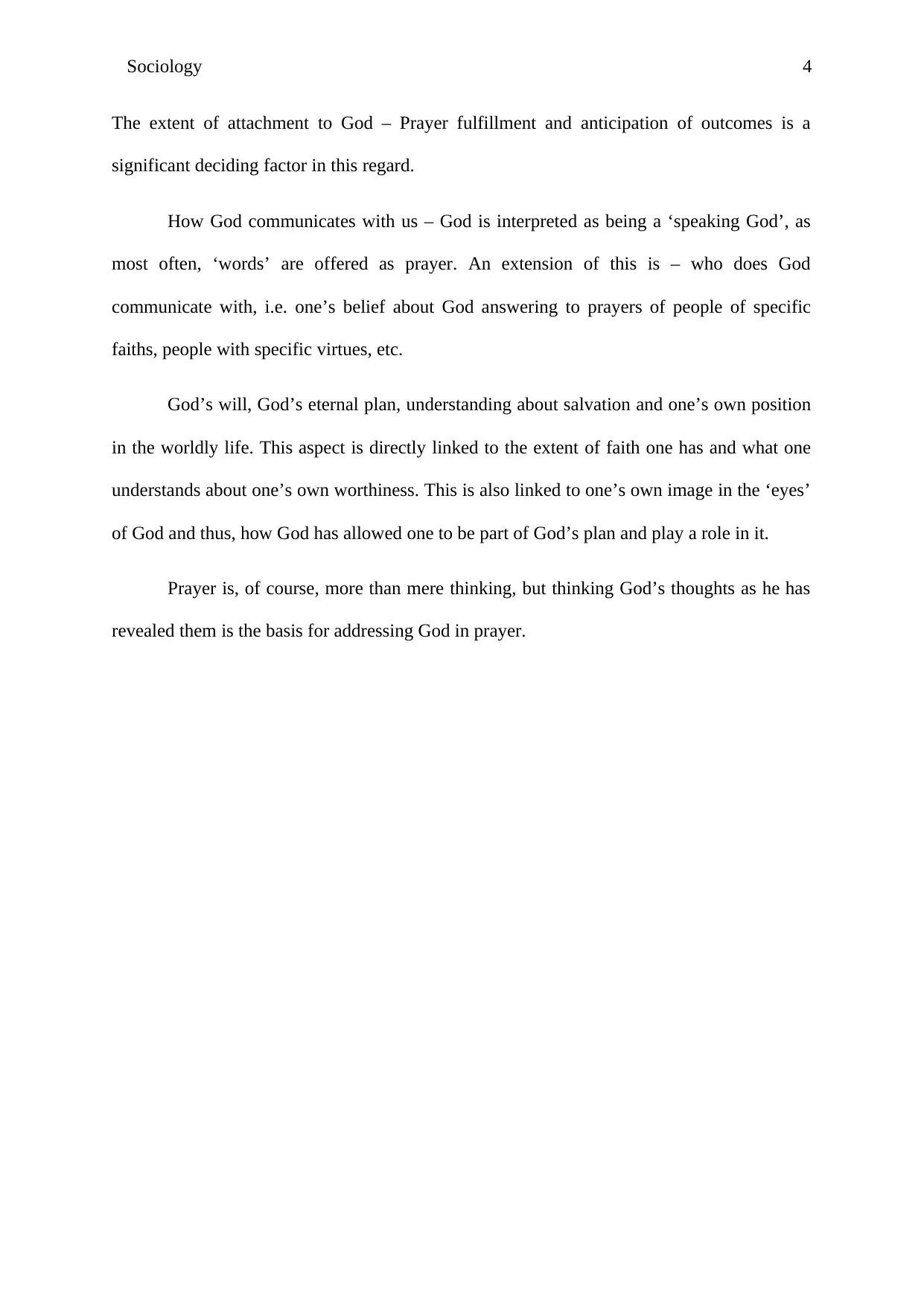
Sociology 4
The extent of attachment to God – Prayer fulfillment and anticipation of outcomes is a
significant deciding factor in this regard.
How God communicates with us – God is interpreted as being a ‘speaking God’, as
most often, ‘words’ are offered as prayer. An extension of this is – who does God
communicate with, i.e. one’s belief about God answering to prayers of people of specific
faiths, people with specific virtues, etc.
God’s will, God’s eternal plan, understanding about salvation and one’s own position
in the worldly life. This aspect is directly linked to the extent of faith one has and what one
understands about one’s own worthiness. This is also linked to one’s own image in the ‘eyes’
of God and thus, how God has allowed one to be part of God’s plan and play a role in it.
Prayer is, of course, more than mere thinking, but thinking God’s thoughts as he has
revealed them is the basis for addressing God in prayer.
The extent of attachment to God – Prayer fulfillment and anticipation of outcomes is a
significant deciding factor in this regard.
How God communicates with us – God is interpreted as being a ‘speaking God’, as
most often, ‘words’ are offered as prayer. An extension of this is – who does God
communicate with, i.e. one’s belief about God answering to prayers of people of specific
faiths, people with specific virtues, etc.
God’s will, God’s eternal plan, understanding about salvation and one’s own position
in the worldly life. This aspect is directly linked to the extent of faith one has and what one
understands about one’s own worthiness. This is also linked to one’s own image in the ‘eyes’
of God and thus, how God has allowed one to be part of God’s plan and play a role in it.
Prayer is, of course, more than mere thinking, but thinking God’s thoughts as he has
revealed them is the basis for addressing God in prayer.
Paraphrase This Document
Need a fresh take? Get an instant paraphrase of this document with our AI Paraphraser
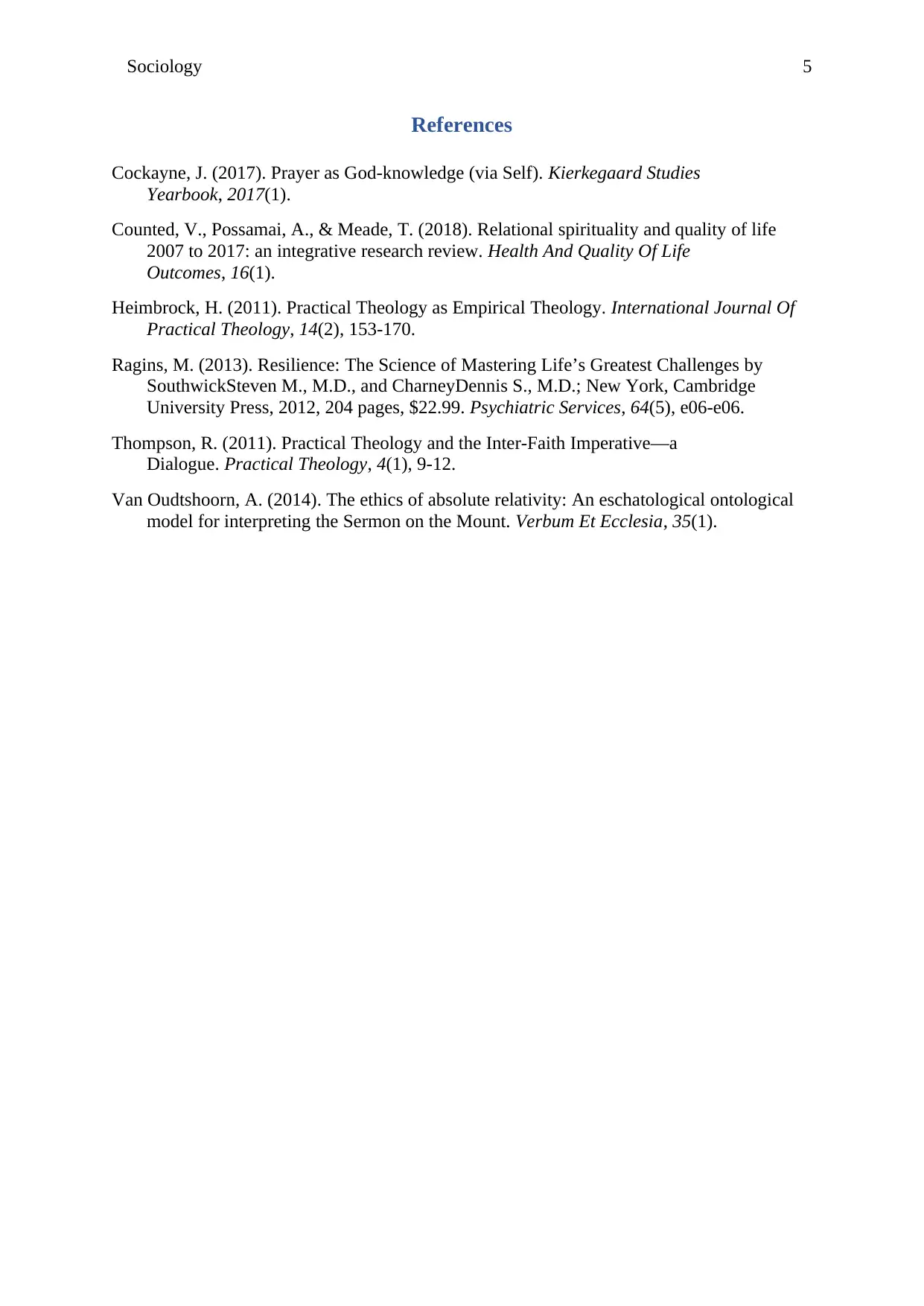
Sociology 5
References
Cockayne, J. (2017). Prayer as God-knowledge (via Self). Kierkegaard Studies
Yearbook, 2017(1).
Counted, V., Possamai, A., & Meade, T. (2018). Relational spirituality and quality of life
2007 to 2017: an integrative research review. Health And Quality Of Life
Outcomes, 16(1).
Heimbrock, H. (2011). Practical Theology as Empirical Theology. International Journal Of
Practical Theology, 14(2), 153-170.
Ragins, M. (2013). Resilience: The Science of Mastering Life’s Greatest Challenges by
SouthwickSteven M., M.D., and CharneyDennis S., M.D.; New York, Cambridge
University Press, 2012, 204 pages, $22.99. Psychiatric Services, 64(5), e06-e06.
Thompson, R. (2011). Practical Theology and the Inter-Faith Imperative—a
Dialogue. Practical Theology, 4(1), 9-12.
Van Oudtshoorn, A. (2014). The ethics of absolute relativity: An eschatological ontological
model for interpreting the Sermon on the Mount. Verbum Et Ecclesia, 35(1).
References
Cockayne, J. (2017). Prayer as God-knowledge (via Self). Kierkegaard Studies
Yearbook, 2017(1).
Counted, V., Possamai, A., & Meade, T. (2018). Relational spirituality and quality of life
2007 to 2017: an integrative research review. Health And Quality Of Life
Outcomes, 16(1).
Heimbrock, H. (2011). Practical Theology as Empirical Theology. International Journal Of
Practical Theology, 14(2), 153-170.
Ragins, M. (2013). Resilience: The Science of Mastering Life’s Greatest Challenges by
SouthwickSteven M., M.D., and CharneyDennis S., M.D.; New York, Cambridge
University Press, 2012, 204 pages, $22.99. Psychiatric Services, 64(5), e06-e06.
Thompson, R. (2011). Practical Theology and the Inter-Faith Imperative—a
Dialogue. Practical Theology, 4(1), 9-12.
Van Oudtshoorn, A. (2014). The ethics of absolute relativity: An eschatological ontological
model for interpreting the Sermon on the Mount. Verbum Et Ecclesia, 35(1).
1 out of 5
Related Documents
Your All-in-One AI-Powered Toolkit for Academic Success.
+13062052269
info@desklib.com
Available 24*7 on WhatsApp / Email
![[object Object]](/_next/static/media/star-bottom.7253800d.svg)
Unlock your academic potential
Copyright © 2020–2025 A2Z Services. All Rights Reserved. Developed and managed by ZUCOL.




